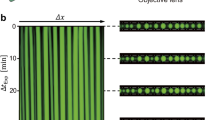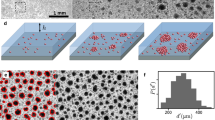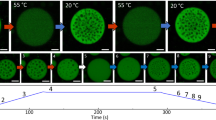Abstract
There are essentially three hypotheses on the original organic aggregates which gave rise to the first cells: they are based either on the polynucleotides (or their precursors) endowed with enzymatic activity of the so-called RNA world, or on liposomes, or on the coacervates usually called proteinoid microspheres (Fox et al., 1959; Fox and Dose, 1977; Honda et al., 1993; Fox, 1995). In the last few years, the third hypothesis has been somewhat neglected, in spite of the great difficulties the other two are facing (Rizzotti, 1994, 1997).
Access this chapter
Tax calculation will be finalised at checkout
Purchases are for personal use only
Preview
Unable to display preview. Download preview PDF.
Similar content being viewed by others
References
Bellarmy L. J. (1958) The infrared spectra of complex molecules, Methuen, London.
Fox S. W. (1965) A theory of macromolecular and cellular origins. Nature 205, 328–340.
Fox S. W. (1995) Thermal synthesis of amino acids and the origin of life. Geochim. Cosmochim. Acta 59, 1213–1214.
Fox S. W., Dose K. (1977) Molecular evolution and the origin of life, Freeman, San Francisco.
Fox S. W., Harada K., Kendrick J. (1959) Production of spherules from synthetic proteinoid and hot water. Science 129, 1221–1223.
Griffiths P. R., de Haseth J. A. (1986) Fourier transform infrared spectrometry, Wiley, New York.
Honda H., Maezawa M., Imai E., Matsuno K. (1993) Catalytic accretion of thermal heterocomplex molecules from amino acids in aqueous milieu. Orig. Life 23, 177–183.
Miller S. L. (1987) Which organic compounds could have occurred on the prebiotic Earth? Cold Spring Harbor Symp. Quant. Biol. LII, 17–27.
Rizzotti M. (1994) Lipid vesicles: are they plausible primordial aggregates? J. Biol. Physics 20, 155–162.
Rizzotti M. (1997) Did a precellular RNA world ever exist? in Cosmovici C. B., Bowyer S., Werthimer D. (eds.) Astronomical and biochemical origins, Compositori, Bologna, pp. 477–481.
Rizzotti M., Mazzei P. (in press) Aggregati precellulari: variazioni sperimentali sulle microsfere. Annales Biotheoretici 2.
Author information
Authors and Affiliations
Editor information
Editors and Affiliations
Rights and permissions
Copyright information
© 1998 Springer Science+Business Media Dordrecht
About this paper
Cite this paper
Rizzotti, M., Crisma, M., De Luca, F., Iobstraibizer, P., Mazzei, P. (1998). Did the First Cell Emerge from a Microsphere ?. In: Chela-Flores, J., Raulin, F. (eds) Exobiology: Matter, Energy, and Information in the Origin and Evolution of Life in the Universe. Springer, Dordrecht. https://doi.org/10.1007/978-94-011-5056-9_27
Download citation
DOI: https://doi.org/10.1007/978-94-011-5056-9_27
Publisher Name: Springer, Dordrecht
Print ISBN: 978-94-010-6124-7
Online ISBN: 978-94-011-5056-9
eBook Packages: Springer Book Archive




